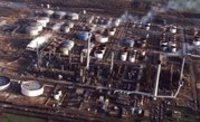OFFSHORE MARINE TERMINAL AND ASSOCIATED ONSHORE RECEIVING FACILITIES DESIGN
- Client: Aguirre Offshore GasPort
- Location: South Coast of Puerto Rico
BACKGROUND
The Aguirre Offshore GasPort Project was designed to provide an offshore marine terminal and associated Onshore Receiving Facility (ORF) to support the continuous offshore re-gasification of liquefied natural gas (LNG) for onward delivery to onshore delivery points.
PROJECT OVERVIEW
The Fire & Gas Detection systems will continuously monitor each fire area of the Aguirre Offshore Marine Terminal for abnormal conditions. In the event of a hazardous situation, the Fire & Gas Detection system (F&G) will:
- Initiate executive actions (firewater pumps, water mist system, water curtain and fire monitors).
- Interface with the ESD system to further cascade the responses.
KEY ASPECTS OF DELIVERY
The different components of the Aguirre Offshore Marine Terminal Fire & Gas Detection system are:
- Fire & Gas detectors throughout the installation.
- Marshalling cabinets that collect information from field devices and exchange signals with logic controllers.
- Visual and audible alarm devices.
- Control devices of fire protection systems (deluge valve, pressure transmitters).
- Interface with equipment local control panel.
- Output signals to other systems to initiate appropriate executive actions:
- To HVAC system
- To electrical control system to initiate electrical power isolation
- To ESD system
- The Fire & Gas detection system shall be fed from the UPS system.
- All information coming from the Fire & Gas detection system shall be reported to the CCR on the operators’ stations.
CLEVER THINKING
The use of a risked based approach and the use of leak detection and flange guards to control leaks allowed a more appropriate design of detection and protection system to be employed. Other more conservative approaches have resulted in excessive use of equipment to achieve the same level of protection.
BENEFITS TO CLIENT
- A much reduced number of detection equipment
- Full understanding of the risks and the mitigation measures
- A more cost effective (ALARP) fire and gas design
